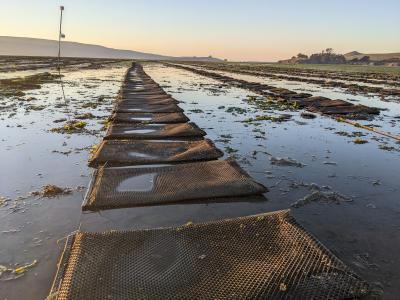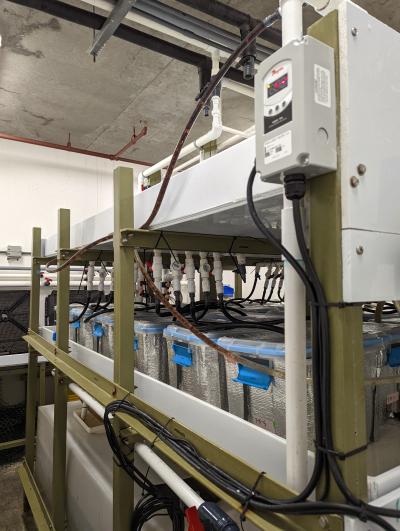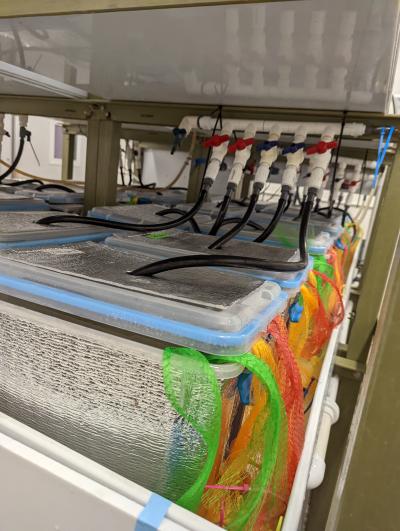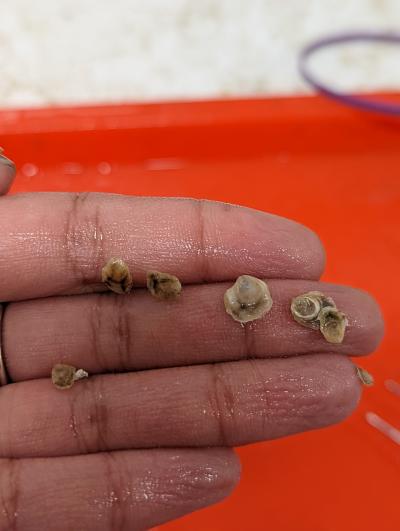Oysters are masters of many things. They can breathe with gills, just like fish. They filter and clean a standard bathtub worth of water every day. They can also change their sex. Most start out as male but switch to female during their lifespan, which can reach up to 30 years.

However, there’s one thing these bivalves struggle with: climate change. As the ocean warms and becomes more acidic, oysters find it harder to construct their shells, making them more prone to disease. Of particular concern is the oyster herpes virus (OsHV-1). This distant relative of the human herpes virus was first detected in these shellfish in the 1990s. After causing outbreaks in Europe and Australia, it spread to the Pacific oyster (Crassostrea gigas) in California. In humans, the herpes virus infamously causes cold sores, but in oysters “the pathogen takes over and can eventually cause the oyster to die,” says Priya Shukla, a California Sea Grant Graduate Research Fellow. Mortality often reaches over 80 percent. (Humans can’t catch the herpes virus from eating an infected oyster.) “Outbreaks tend to happen once temperatures reach 16 degrees Celsius or about 61 degrees Fahrenheit,” says Shukla. This is bad news, since water in the traditional oyster farming areas of California, like Tomales Bay, now often crosses that threshold.
Shukla wondered if anything could be done. Recently, the marine ecologist has started running what she jokingly calls “a boot camp” for baby oysters in her laboratory. Shukla exposes newly spawned oysters to controlled blasts of 21-degree Celsius warm seawater (about 70 degrees Fahrenheit). She hopes these blasts will toughen up the shellfish for life in a changing ocean.

“Just as continuously exercising your body makes you stronger, exposure to temperature stress can help oysters deal with other environmental stressors because they're able to develop cellular mechanisms to cope,” says Shukla.
She then transfers her boot camp oysters to Tomales Bay to see how they fare. With its long and narrow shape, this inlet, located about one hour north of San Francisco, forms a natural experiment. “In summer, the part closest to the ocean is coolest while the part furthest away is warmest,” says Shukla, who is monitoring how her toughened up baby oysters are doing in their new environment.
Aquacultured shellfish, including oysters, mussels and clams, is a $270 million business along the U.S. West Coast. Currently, over 300 commercial shellfish farms operate in that area, supporting nearly 4,000 jobs. Worldwide, the aquaculture of the Pacific oyster is worth more than $3 billion dollars. But saving the Pacific oyster goes beyond economic considerations. As the world population grows, finding sustainable sources of protein becomes ever more important. Oysters, which typically grow to shell lengths of 10 to 15 centimeters (four to six inches), fit the bill.
Oysters also play a vital ecological role. Because they filter algae and other particles from the water they draw over their gills, these shellfish help keep estuarine and coastal waters clean, which promotes the growth of native seabed grasses like wild celery. These plants, in turn, provide shelter and shade for young fish. And by settling in clusters on rocks and other hard surfaces, oysters build up reefs that act as buffers in stormy seas and protect shorelines against erosion.

So is the boot camp working? Shukla is still analyzing the numbers, but the initial results look promising. “We have some data from a herpesvirus outbreak last summer that suggests that baskets with oysters that were exposed to warmer temperatures during the boot camp had greater survival,” says Shukla.
As a vegetarian, Shukla won’t be eating oysters herself anytime soon. But as the daughter of Indian immigrants who hail from central India, where her family farmed crops like jackfruit and rice, she is thrilled that her work might help other farmers, in this case those in aquaculture.
“I’m excited especially because exploring ways to help farmed oysters tolerate warming waters could be also beneficial to wild species that are in decline.”
Shukla’s boot camp experiment — which is run in partnership with the Hog Island Oyster Company in Tomales Bay — will continue until September 2022. Should the results hold up, commercial oyster nurseries might start routinely exposing their hatcheries to blasts of warm water to train their baby shellfish and add yet another capability to the already impressive list of oyster skills: learning to live with climate change.
Additional facts about oysters:
Oysters, which include different species, live in the ocean all over the world, mostly in shallow brackish and saltwater bays, estuaries and intertidal zones that are submerged at high tide. Oysters reproduce by spawning tiny larvae that swim freely until they find a hard surface on which they settle for the rest of their lives. Humans have eaten oysters since prehistoric times. Due to overharvesting and diseases, oyster reefs are now considered one of the most endangered marine habitats, with an estimated 85 percent of wild reefs having been lost over the past century.

About California Sea Grant
NOAA’s California Sea Grant College Program funds marine research, education and outreach throughout California. Headquartered at Scripps Institution of Oceanography at the University of California San Diego, California Sea Grant is one of 34 Sea Grant programs in the National Oceanic and Atmospheric Administration (NOAA), U.S. Department of Commerce.